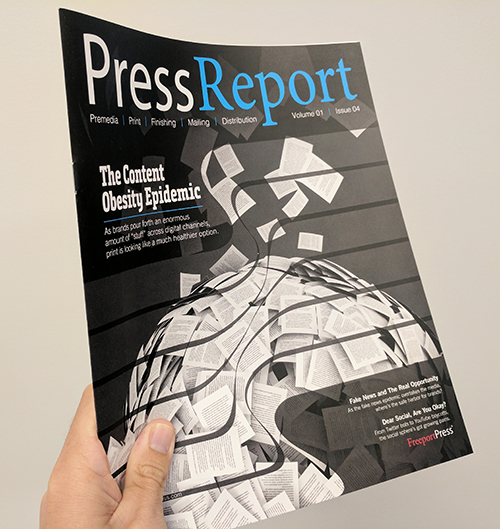 “If you’re going to invest in print,” writes Raindrop’s Adam Wagner in Forbes, “make it amazing.”
“If you’re going to invest in print,” writes Raindrop’s Adam Wagner in Forbes, “make it amazing.”
Wagner is talking about the strategic impact that print can make in your marketing, what he calls the “bow” on your brand experience. He believes that, as digital becomes more prevalent, “there are moments when a high-touch piece of print collateral can make a surprisingly profound impact.”
The reason has to do as much with human nature as it does with the art of marketing.
“People appreciate print collateral for the same reason they use handouts and take handwritten notes in meetings,” he writes. “Paper is ingrained in humanity, dating back to the earliest civilizations that used woven papyrus as a writing surface.”
Science – and in particular neuromarketing — backs Wagner up on this; our human brains are hardwired to respond better to print than digital. Print just delivers a more tactile – and therefore more memorable – experience.
Yet Wagner offers some sound advice as you plan your next printed piece.
“Before we go any further, let’s make one thing clear: As we pump up the marketing value of printed materials, we’re referring only to those that are unique, thoughtful and creative,” he writes. “A static folder with a few sell sheets does not qualify as impactful collateral. If you’re going to invest in print, make it amazing.”
Done right, print’s superpowers aren’t matched by digital, especially when you are aiming to leave a lasting impression with your brand.
“We call it a ‘leave-behind’ because it is meant to extend your presence,” Wagner explains. “After your meeting with a prospect is over and you leave them to make a buying decision, a leave-behind subtly reinforces your brand by keeping you ‘top of mind’ in the same vein as email or social media marketing — only your content is actually on their desk where they work every day instead of buried in their inbox or social feed.”
And as brands embrace the “print proud and digital smart” mantra, we know there is no either/or here. Print and digital work together to support each other, pulling on their own strengths to move the needle.
“There is a balance between the two, and each supports efforts in the other,” Wagner concludes. “We are living and working in an experience economy, where people are anxious to share even the smallest piece of positivity in their day. When you surprise and delight someone via print, the brand experience drives them back (and back again) to the digital channels you are working so hard to build.”
Surprise and delight – the hallmarks of a quality printed piece, and the best brand leave-behind you could ask for.

January 2, 2020, 10:53 am